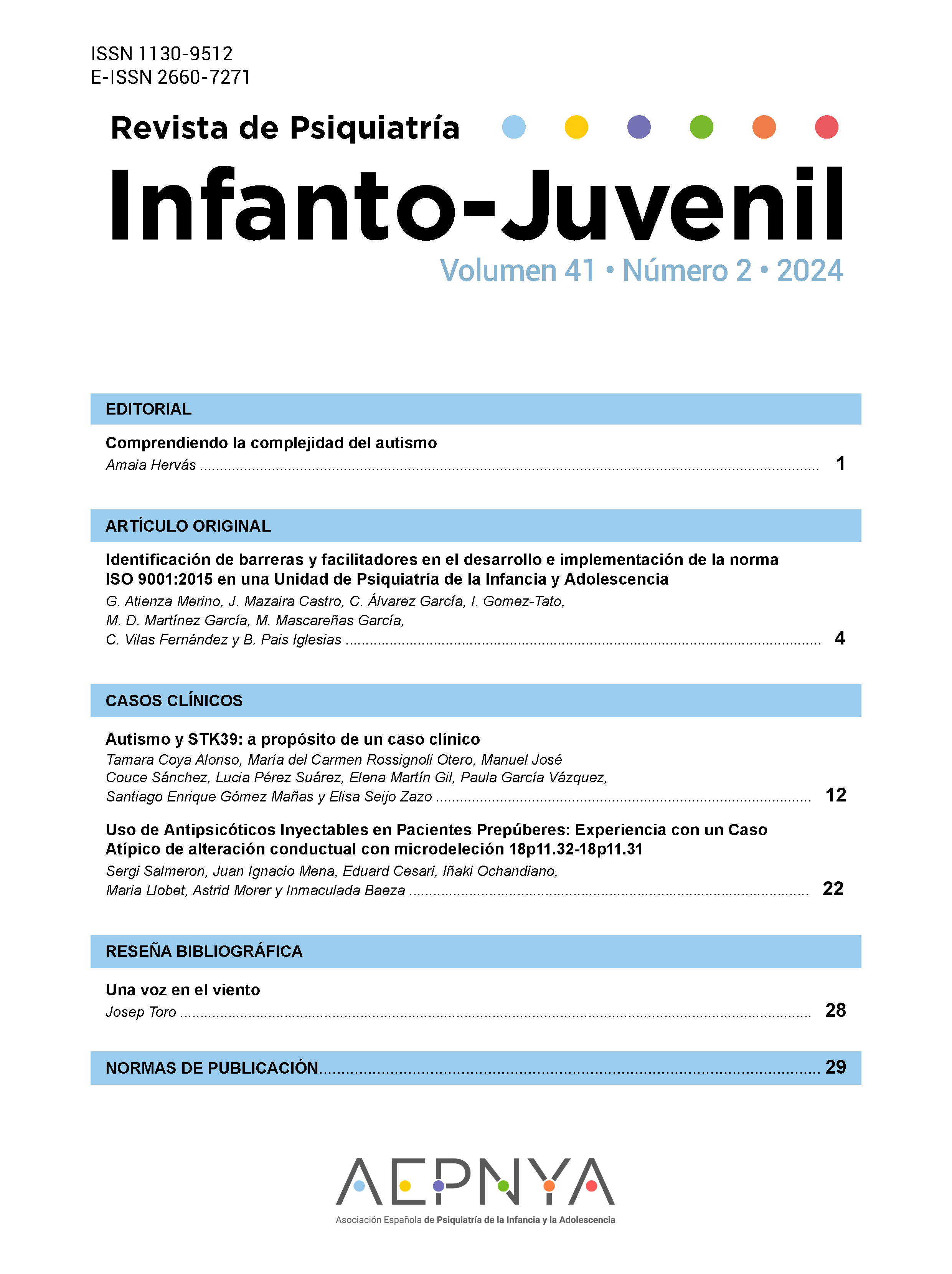Autismo y STK39: a propósito de un caso clínico
Publicado
Cómo citar
Número
Sección
Licencia
Derechos de autor 2024 Revista de Psiquiatría Infanto-Juvenil

Esta obra está bajo una licencia internacional Creative Commons Atribución-NoComercial-SinDerivadas 4.0.
DOI:
https://doi.org/10.31766/revpsij.v41n2a3Palabras clave:
trastorno del espectro autista, trastorno del neurodesarrollo, STK39, psicótico, caso clínicoResumen
STK39 es un gen que codifica para la serina/treonina quinasa, localizado en el cromosoma 2q24.3. Conocido también por sus homólogos SPAK/PASK/STE20-SPS1, se encuentra abundantemente expresado en el cerebro con funciones en la diferenciación celular, la transformación y proliferación celular. En la literatura se han encontrado diversos artículos donde se muestra una asociación de dicho gen con neoplasias renales y hepáticas fundamentalmente. Usando los términos autismo, genética, STK39 y psicosis, se ha realizado una búsqueda en los periodos comprendidos desde 2018 a 2023 en PubMed. El caso clínico relatado a continuación versa sobre unas hermanas mellizas, portadoras de dicho gen, con el diagnóstico de trastorno del espectro del autismo (TEA) y discapacidad intelectual, así como comorbilidad orgánica para ambas. En una de ellas, tal y como se presenta, se desarrolla un episodio psicótico a los 12 años de edad. A pesar de que el gen STK39 no está descrito como uno de los genes más frecuentemente responsable de la expresión de TEA, un estudio en la literatura apoya que el STK39 sería un nuevo gen candidato para el TEA.
Descargas
Citas
Zhang C, Wang X, Fang D, Xu P, Mo X, Hu C, Abdelatty A, Wang M, Xu H, Sun Q, Zhou G, She J, Xia J, Hui KM, Xia H. STK39 es una nueva quinasa que contribuye a la progresión del carcinoma hepatocelular por la vía de señalización PLK1/ERK. Teranósticos. 2021 Jan;11(5): 2108-22. https://doi.org/10.7150/thno.48112. DOI: https://doi.org/10.7150/thno.48112
Wang J, Fan Z, Li J, Yang J, Liu X, Cheng J. Transcription factor specificity protein 1-mediated Serine/threonine kinase 39 upregulation promotes the proliferation, migration, invasion and epithelial-mesenchymal transition of hepatocellular carcinoma cells by activating the transforming growth factor-B1 /Smad2/3 pathway. Bioengineered. 2021 Dec;12(1): 3566-77. https://doi.org/10.1080/21655979.2021.1947939 DOI: https://doi.org/10.1080/21655979.2021.1947939
Zhao Q, Zhu Y, Liu L, Wang H, Jiang S, Hu X, Guo J. El bloqueo de STK39 por interferencia de ARN inhibe la proliferación e induce la apoptosis del carcinoma de células renales. Onco apunta a Ther. 16 de marzo de 2018;11:1511-1519. https://doi.org/10.2147/OTT. S153806 DOI: https://doi.org/10.2147/OTT.S153806
Wu C-Y, Wu J-D, Chen C-C. The Association of Ovarian Teratoma and Anti-N-Methyl-D-Aspartate Receptor Encephalitis: An Updated Integrative Review. International Journal of Molecular Sciences. 2021;22(20): 10911. https://doi.org/10.3390/ijms222010911 DOI: https://doi.org/10.3390/ijms222010911
OMS. CIE-10 Trastornos mentales y del comportamiento. Meditor. J.J.Lopez Ibor. 1992. Lord C, Elsabbagh M, Baird G, Veenstra-Vanderweele J. Trastorno del espectro autista. Lancet. 2018;392(10146): 508-20. https://doi.org/10.1016/S0140-6736(18)31129-2 DOI: https://doi.org/10.1016/S0140-6736(18)31129-2
Vorstman JAS, Parr JR, Moreno-De-Luca D, Anney RJL, Nurnberger JI Jr, Hallmayer JF. Genética del autismo: oportunidades y retos para la traslación clínica. Nat Rev Genet. junio de 2017; 18(6):362-376. https://doi.org/10.1038/nrg.2017.4 DOI: https://doi.org/10.1038/nrg.2017.4
Galbe Sánchez-Ventura J, Pallás Alonso CR, Rando Diego Á, Sánchez Ruiz-Cabello FJ, Colomer Revuelta J, Cortés Rico O, et al. Detección precoz de los trastornos del desarrollo (parte 2): trastornos del espectro autista. Pediatr Aten Primaria [Internet]. 2018 [citado el 3 de diciembre de 2023]; 20(79): 277-85. Disponible en: https://scielo.isciii.es/scielo.php?script=sci_arttext&pid=S1139-76322018000300016
Leblond CS, Le TL, Malesys S, Cliquet F, Tabet AC, Delorme R, Rolland T, Bourgeron T. Lista operativa de genes asociados con el autismo y los trastornos del neurodesarrollo basada en la revisión de la base de datos. Neurosci de células molares. Junio de 2021;113:103623. https://doi.org/10.1016/j.mcn.2021.103623. DOI: https://doi.org/10.1016/j.mcn.2021.103623
Bejerot S, Eriksson JM. Sexualidad y rol de género en el trastorno del espectro autista: un estudio de casos y controles. PLoS Uno. 31 de enero de 2014; 9(1):e87961. https://doi.org/10.1371/journal.pone.0087961 DOI: https://doi.org/10.1371/journal.pone.0087961
Braden BB, Pagni BA, Monahan L, Walsh MJM, Dixon MV, Delaney S, Ballard L, Ware JE Jr. Calidad de vida en adultos con trastorno del espectro autista: influencia de la edad, el sexo y una intervención piloto controlada, aleatorizada y basada en la atención plena para la reducción del estrés. Res. de Vida Cualificada 2022 Mayo; 31(5):1427-1440. https://doi.org/10.1007/S11136-021-03013-X DOI: https://doi.org/10.1007/s11136-021-03013-x
Lai MC, Lombardo MV, Auyeung B, Chakrabarti B, Baron-Cohen S. Diferencias de sexo/género y autismo: preparando el escenario para futuras investigaciones. J Am Acad Psiquiatría Infanto-Juvenil. Enero de 2015;54(1):11-24. https://doi.org/10.1016/j.jaac.2014.10.003 DOI: https://doi.org/10.1016/j.jaac.2014.10.003
Waye MMY, Cheng HY. Genética y epigenética del autismo: una revisión. Psiquiatría Clin Neurosci. Abril de 2018;72(4): 228-244. https://doi.org/10.1111/pcn.12606. DOI: https://doi.org/10.1111/pcn.12606
Mühle R, Trentacoste SV, Rapin I. La genética del autismo. Pediatría. mayo de 2004; 113(5):E472-86. https://doi.org/10.1542/peds.113.5.e472 DOI: https://doi.org/10.1542/peds.113.5.e472
Ramoz N, Cai G, Reichert JG, Silverman JM, Buxbaum JD. Un análisis de loci candidatos a autismo en el cromosoma 2q24-q33: evidencia de asociación con el gen STK39. Am J Med Genet B Neuropsychiatr Genet.5 de octubre de 2008; 147B(7): 1152-8. https://doi.org/10.1002/ajmg.b.30739 DOI: https://doi.org/10.1002/ajmg.b.30739
Modabbernia A, Velthorst E, Reichenberg A. Factores de riesgo ambientales para el autismo: una revisión basada en la evidencia de revisiones sistemáticas y metaanálisis. Mol Autismo. 17 de marzo de 2017;8:13. https://doi.org/10.1186/s13229-017-0121-4 DOI: https://doi.org/10.1186/s13229-017-0121-4
¿Se puede confundir el autismo con la esquizofrenia? Tony Attwood y la Dra. Michelle Garnett [sitio web]. Disponible en: https://attwoodandgarnettevents.com/can-autism-be-confused-with-schizophrenia/
Artigas-Pallarès J, Paula I. El autismo 70 años después de Leo Kanner y Hans Asperger. Rev. Asoc. Esp. Neuropsiq, 2012; 32 (115), 567-587. https://doi.org/10.4321/S0211-57352012000300008. DOI: https://doi.org/10.4321/S0211-57352012000300008
Hervás A. Un autismo, varios autismos. Variabilidad fenotípica en los trastornos del espectro autista. Rev Neurol. 2016;62 (supl 1): S9-S14. DOI: https://doi.org/10.33588/rn.62S01.2016068









 © 2021 AEPNyA Todos los derechos reservados
© 2021 AEPNyA Todos los derechos reservados
